- Unknown distribution. In Oceania, symptoms of toxicity recorded in Fiji (possibly), Papua New Guinea, Vanuatu. On tomato. Residual herbicide a possible cause.
- Damage: twisting of leaves, bunching of terminate growth, stunting of plants.
- Reasons for residual herbicide and toxicity include: (i) soils (sandy, low clay) that fail to bind, e.g., glyphosate; (ii) frequent applications; (iii) applications at high concentrations; (iv) applications of phosphorus fertilizer (competing with glyphosate for soil binding sites); (v) addition of other herbicides to increase residual activity.
- Control:
- Avoid land where glyphosate applied frequently and/or at high rates, or wait at least 40 days between last application before re-planting
- Make sure sprays only contains glyphosate, i.e., no other chemical present to increase possible residual activity in soil.
- READ THE LABEL CAREFULLY.
- Alternatively, carry out a bioassay (see below): transplant test seedlings (tomato) across area prior to planting entire crop. Inspect for toxicity after 7-14 days.






